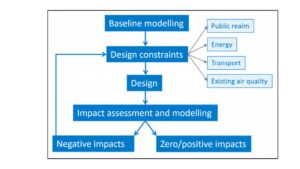This website uses cookies so that we can provide you with the best user experience possible. Cookie information is stored in your browser and performs functions such as recognising you when you return to our website and helping our team to understand which sections of the website you find most interesting and useful.
The forthcoming Air Quality Positive London Plan Guidance (2021) relates to London Plan Policy SI1 Improving Air Quality. This requires proposed large-scale developments in London, subject to an Environmental Impact Assessment (EIA), to submit an Air Quality Positive (AQP) Statement at the planning application stage. The air quality positive approach outlines how new developments can minimise exposure to poor air quality while also improving and benefiting local air quality. It is therefore important that the project’s air quality and design teams engage at the earliest opportunity to ensure air quality is being considered from the beginning of the project.
This will allow AQP measures to be included at an early stage to be cost efficient, effective and to maximise the potential positive benefits. The AQP approach is not an assessment in its own right, instead, it brings together a range of evidence to show how air quality has been considered holistically within the design of a development. It is important to note that measures aimed at improving air quality or reducing exposure to poor air quality must now be designed into the scheme in its early stages, rather than recommended as mitigation measures to reduce a development’s potentially negative impacts.
Following these early engagements between stakeholders, the air quality team will prepare the AQP Statement. This will outline the development site’s specific air quality constraints and opportunities and assess the effectiveness and suitability of each measure outlined by the design team to combat air quality issues, either quantitively or qualitatively, depending on the measure proposed.
The AQP Statement is required to give evidence to show how air quality considerations have informed the design of the development, why specific measures have been adopted, and how they will positively influence air quality in the vicinity of the development. These expected benefits need to be backed up by “reasonable evidence”, which is where the air quality team will need to assess each measure to determine its actual positive impact on air quality. Finally, justification will need to be given summarising why measures that could be reasonably expected, have not been used. This could be expected measures not being suitable for the proposed development due to constraints surrounding the development’s size or positioning in the wider area, or because other proposed measures will have a much greater beneficial impact on local air quality.
The figure below broadly outlines a schematic approach needed to assess an air quality positive development, taken from the forthcoming guidance. It shows how the emphasis has been put on potential design constraints and remedying them.

Air Quality Positive London Plan Guidance (2021)
Ensuring that a mix of measures to combat potential air quality issues have been considered will positively impact air quality at different scales; such as, within the development, in the area immediately surrounding the development, in the wider general area and regionally. Small scale measures such as strategic tree and vegetation planting along roadsides and around public green spaces can reduce air pollution impacts, while larger scale measures including building design and road and transport link layouts can contribute to improved air quality in the surrounding areas and also promote sustainable travel options for the wider community. These impacts will be assessed, and measures secured individually, but it is the sum of the measures that will determine an AQP development.
The Temple Air Quality Team will take these measures and assess the impacts using a range of methods and tools, as it will not always be possible to follow the usual air quality assessment approach of evaluating against set thresholds and limits. Dispersion models such as ADMS is one of the tools used to quantify the positive impact of travel plans or road realignments. Dispersion models will also be used to describe the existing air quality environment within and around the proposed development site and will be crucial in trying to understand and quantify, the impact of certain design options. From an AQP perspective, this can inform design teams decisions on how to progress to the more detailed design stages. Where dispersion models are not appropriate for the design measure proposed, qualitative assessment tools will be required to robustly analyse the predicted influence of the action.
The Temple Air Quality Team has considerable experience in undertaking air quality assessments and monitoring on large projects, as well as producing air quality monitoring data and reports. We liaise with regulators at an early stage to agree the scope of an assessment upfront, minimising the chances that an application will be delayed or refused on air quality grounds. We advise our clients throughout the design and construction stage of a scheme, helping them discharge air quality related planning conditions such as those requiring a low emissions strategy, contributing to construction environmental management plans, and undertaking dust monitoring as construction progresses. We also hold a number of Osiris monitors in house and can be rapidly deployed on site to measure TSP, PM10, PM2.5 particles.
